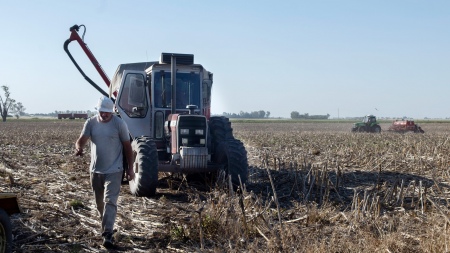The persistent drought that affects a large part of the country’s agricultural area, to which late frosts have recently been addedhit wheat in such a way that many producers in the core zone decided not to harvest its poor fruits, and took advantage of the rains of the last few days to start planting soybeans on the lots occupied with the cereal.
In a tour carried out in recent days by the agency Télam on different points of the agricultural region between the north of the province of Buenos Aires, south center of Santa Fe and southeast of Córdobathe images of planters planting soybeans on the scrawny wheat that is still standing is a constant.
The producers with whom Télam was able to speak during the tour They described the effects of the drought as something “unprecedented”.
“We’ve never seen anything like it. My father is 73 years old and he says that this is the first time he has seen five months go by without rain,” the producer from the Junín area, Pablo Ferrari, told Télam.
“We’ve never seen anything like this. My father is 73 years old and he says it’s the first time he’s seen five months go by without rain”Pablo Ferrari, producer from Junín
As detailed by the producer, who rents fields adjacent to said Buenos Aires town, “On May 25, the last important rain that allowed us to sow wheat occurred and from then on nothing happened here. It would have to rain about 1,000 millimeters per year, but today we are, in November, barely 400 millimeters.”
“I work 600 hectares all rented. In the wheat that we ‘burn’ (herbicide is sprayed to dry it) we had an expense of US$ 500 per hectare that was thrown away. To this we must add the rent, so for the soybeans that I am planting I need about 1,500 extra kilos to cover that expense. It will be a year to spend it with the least possible loss,” Ferrari said.
The core area is agricultural par excellence, that although it is not the one that contributes the most wheat at the national level, the productive losses that will occur in said region will be so forceful that the Rosario Stock Exchange (BCR) classified it as a “productive disaster”, stating that the fall in production it will be 83%, going from 7.8 million tons to 1.6 million.

As you enter the area, the “productive disaster” becomes palpable: Yellow and dry wheat of small stature paints the scene at the side of the roads, despite the fact that the shoulders are green for a few days thanks to the rains.
As you turn off country lanes and enter fields, where tractors abound pulling planters to plant soybeans on the still standing wheat, you can see ears with empty grains, for which it is not worth starting the harvesters.
“What happened is tremendous, something never seen and unprecedented for the area. In these fields there are always shallows or lagoons, but now they are all dry”Gustavo Frederking told Télam, who calculated that production in the area will be 15% of the volume that is usually harvested.
Such is the bad state of the wheat that Frederking decided to start planting soybeans and released cows in the lots and made rolls with the cereal. “It is a very tough decision, so much so that some producers are going to harvest it anyway, because in their head they do not accept what is happening. We are not used to not having a harvest,” said the producer.

For Edmundo Nolan, a producer from the Venado Tuerto area, “It’s kind of maddening to see the wheat there. It is never good to lose an illusion. For us, the harvest was always a party, but today we can’t afford it.”
“For this reason, one is changing a reality which is that I am going to reap something that is not going to give me even to pay the person who is going to come to thresh, much less the seeds and fertilizer, for a planting above causing it to be lost. That situation is a wake,” Nolan lamented.
Despite the lack of moisture, the farmer remarked that the effects on the soil will not be the same as they could have been four decades ago, thanks to the implementation of direct sowing.
“Yes, I can say that a dry one of these before would have left us with zero results in everything. With the issue of direct sowing, some things are attenuated, the soil is taken care of and everything is not lost. If this happened 40 years ago, no one would be able to go through the route because we would be covered in a cloud of dust,” he concluded.
For his part, Carlos Covernton, a producer in the area, maintained that neither he nor his father nor his grandfather saw “anything like that. We know something similar happened in 1915, more than 100 years ago.”
In addition, Covernton put numbers on the losses: “Due to the drought, 50% of the wheat in the Venado Tuerto area has already been lost., and went from an expected yield of 50 qq/ha to 25 qq/ha. But the problem is that of what was going to yield 25 qq/ha, 80% was lost due to frost. In other words, 20% of what is sown will be harvested with half the yield.”

For his part, the president of the Sociedad Rural de Pergamino, Jorge Josifovich, highlighted the severity of the drought and said that “although we have suffered quite severe droughts like in 2008 and 2017, this year we are experiencing a much more complex situation. This year we did not receive the average 900 millimeters of precipitation, but 300 millimeters and we had 180 days with frost, which produced the perfect storm for the winter crops to be destroyed.”
According to Josifovich, of the 30,000 hectares that were planted with the cereal in the Pergamino area, one of the hardest hit points in the core area “less than a quarter will be harvested, which means less income for families, less work for carriers and less use of fuel and contractors are going to work at cost, and all these losses are going to spill over into the regional economy, initially, but later it will spill over into the national economy. “.
“We see an affectation in the north of Buenos Aires”
The Buenos Aires Minister of Agrarian Development, Javier Rodríguez, affirmed that the drought is affecting “above all the northern part of the province,” although there are also “some districts in the central zone.”
“We are seeing an affectation especially in the northern part of the province, quite widespread and coincident with the studies that are being shown at the national level from the private sector,” Rodríguez remarked in statements to Radio La Red.
Although “in the case of the province, the affectation is centered in the northern region, it is also in some districts of the central zone,” he clarified.
Given this, the minister highlighted that Governor Axel Kicillof signed the emergency declaration decree on November 11, which, he explained, “leads to a process of registering producers and there is movement regarding that.”
Regarding the wheat areas, Rodríguez pointed out that “affectations are seen, but the total balance of the aggregate number in the most important producing area, in the southeast and southwest, the affectations are of a lesser proportion than what is seen in the north zone.” .
He also stressed: “We come from a very good 2021/2022 campaign, with a general lift that exceeded 22 million tons and that marked a peak in terms of production level much higher than the previous and immediate years.”
“If we compare it with the previous year, the drop is marked, and if we compare it from two to three previous years, there is a clear drop depending on the weather,” added the provincial official.
For this reason, “we moved quickly in the emergency situation, seeing that the winter crops were effectively affected,” he concluded.


















